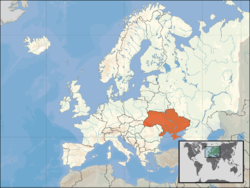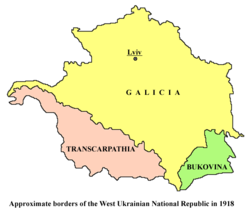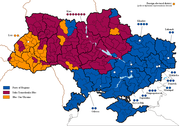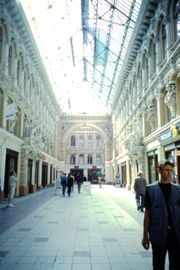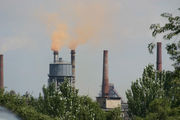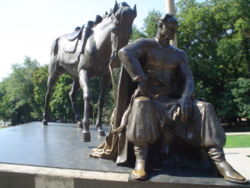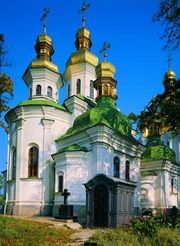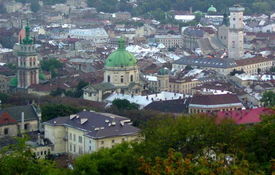Ukraine
2007 Schools Wikipedia Selection. Related subjects: Countries; European Countries
| Україна Ukrayina Ukraine |
|||||
|
|||||
| Anthem: Ukrainian: Ще не вмерла України Transliteration: Shche ne vmerla Ukrajiny "Ukraine's glory has not perished" |
|||||
| Capital | Kiev (Kyiv) |
||||
|---|---|---|---|---|---|
| Largest city | Kiev | ||||
| Official languages | Ukrainian | ||||
| Government | Parliamentary democracy | ||||
| - President | Viktor Yushchenko | ||||
| - Prime Minister | Viktor Yanukovych | ||||
| Independence | from the Soviet Union | ||||
| - Declared | August 24, 1991 | ||||
| - Referendum | December 1, 1991 | ||||
| - Finalized | December 25, 1991 | ||||
| Area | |||||
| - Total | 603,700 km² ( 44th) 233,090 sq mi |
||||
| - Water (%) | negligible | ||||
| Population | |||||
| - 2005 estimate | 46,481,000 ( 27th) | ||||
| - 2001 census | 48,457,102 | ||||
| - Density | 77/km² ( 114th) 199/sq mi |
||||
| GDP ( PPP) | 2005 estimate | ||||
| - Total | $338.5 billion ( 28th) | ||||
| - Per capita | $7,156 ( 87th) | ||||
| HDI (2004) | 0.774 (medium) ( 77th) | ||||
| Currency | Hryvnia ( UAH) |
||||
| Time zone | EET ( UTC+2) | ||||
| - Summer ( DST) | EEST ( UTC+3) | ||||
| Internet TLD | .ua | ||||
| Calling code | +380 | ||||
Ukraine ( Ukrainian: Україна, Ukraina, /ukraˈjina/) is a country in Eastern Europe. It borders Russia to the north-east, Belarus to the north, Poland, Slovakia and Hungary to the west, Romania and Moldova to the south-west, and the Black Sea and Sea of Azov to the south. The historic city of Kiev (Kyiv) is the country's capital.
From at least the ninth century, the territory of present-day Ukraine was a centre of medieval East Slavic civilization forming the state of Kievan Rus, and for the following several centuries the territory was divided between a number of regional powers. After a brief period of independence (1917–1921) following the Russian Revolution of 1917, Ukraine became one of the founding Soviet Republics in 1922. The Ukrainian Soviet Socialist Republic's territory was enlarged westward after the Second World War, and again in 1954 with the Crimea transfer. In 1945 Ukrainian SSR became one of the co-founder members of the United Nations. It became independent again after the Soviet Union's collapse in 1991.
Etymology of the name
According to one theory, the Ukrainian word Ukrayina stems from the Old Slavic root kraj-, meaning ‘land’, ‘region’, ‘country’, but also ‘edge’ or ‘borderland’ (see below). In particular, in Ukrainian krayina means simply ‘country’. Opinions vary as to the immediate derivation, but the first known mentioning in the Kiev Chronicle of 1187 probably uses the word in the meaning of ‘region’, ‘principality’, which might be defined as ‘land cut out for a Prince’ (maybe referring to the general feudal practice of a prince dividing land between his sons). Over time, as the dominant self-identification paradigms were changing, the word's initial meaning ‘the land of the prince’ may have transformed to a wider meaning.
According to another theory, kraj- in the meaning of ‘ borderland’, ‘ frontier’ formed the basis for the modern name of the country (cf. Russian okraina, ‘outskirts’; a semantic parallel to -mark in Denmark, cf. Marches; cf. also Krajina). The voivodship of Kiev, which was called Ukraina from the sixteenth century on, was on the south-eastern border of the Polish-Lithuanian Commonwealth.
In English, the country is sometimes referred to with the definite article, the Ukraine, as in the Netherlands, the Gambia, the Sudan or the Congo. However, usage without the article is becoming more frequent, and has become established in journalism and diplomacy since the country's independence (for example, within the style guides of The Economist, The Guardian and The Times).
History
Human settlement in the territory of Ukraine has been documented into distant prehistory. The late Neolithic Trypillian culture flourished from about 4500 BC to 3000 BC.
Early history of Ukraine (700 BC–700 AD)
In antiquity, the southern and eastern parts of modern Ukraine were populated by Iranian nomads called Scythians. The Scythian Kingdom existed on this land between 700 BC and 200 BC. In the third century, the Goths arrived, calling their country Oium, and formed the Chernyakhov culture before moving on and defeating the Roman empire. In the seventh century the territory of the modern Ukraine was the core of the state of the Bulgars (often referred to as Great Bulgaria) who had their capital in the city of Phanagoria.
The majority of the Bulgar tribes migrated in several directions at the end of the seventh century and the remains of their state was swept by the Khazars, a Turkic semi- nomadic people from Central Asia which later adopted Judaism. The Khazars founded the independent Khazar kingdom in the southeastern part of today's Europe, near the Caspian Sea and the Caucasus. In addition to western Kazakhstan, the Khazar kingdom also included territory in what is now eastern Ukraine, Azerbaijan, southern Russia, and Crimea.
Golden Age of Kiev (800–1100)
During the tenth and eleventh centuries the territory of Ukraine became the centre of a powerful and prestigious state in Europe, Kievan Rus, laying the foundation for the national identity of Ukrainians, as well as other East Slavic nations, through subsequent centuries. Its capital was Kiev, the capital of modern Ukraine, wrestled from Khazars by Askold and Dir in about 860. According to the Primary Chronicle the Kievan Rus' elite initially consisted of Varangians from Scandinavia. The Varangians later became assimilated into the local Slavic population and gave the Rus' its first powerful dynasty, the Rurik Dynasty.
Kievian Rus' was comprised from several principalities, ruled by the interrelated Rurikid Princes. The seat of Kiev, the most prestigious and influential of all principalities, became a subject of many rivalries between Rurikids as the most valuable prize in their quest for power, sometimes through intrigue but often through bloody conflicts. The Golden Age of Kievan Rus' falls on the years of Kiev being ruled by Vladimir the Great (Volodymyr, 980– 1015) who turned Rus' towards the Byzantine Christianity and his son Yaroslav the Wise ( 1019– 1054) during whose lengthy reign, Kievan Rus' reached a zenith of its cultural flowering and military power that was followed by the state's increasing fragmentation as the relative importance of regions rose again. After the one last resurgence under the rule of Vladimir Monomakh 1113– 1125 and his son Mstislav ( 1125– 1132) the Kievan Rus' finally disintegrated into the separate principalities following Mstislav's death. The thirteenth century Mongol invasion dealt Rus' a final blow from which it never recovered.
Polish-Lithuanian Commonwealth (1300–1600)
On the Ukrainian territory, the state of Kievan Rus' was succeeded by the principalities of Halych and Volodymyr-Volynskyi, which were merged into the state of Halych-Volynia. In the mid-fourteenth century it was subjugated by Casimir IV of Poland while the heartland of Rus', including Kiev, fell under the Gediminids of Grand Duchy of Lithuania. Following the 1386 marriage of Lithuania's Grand Duke Jagiello to Poland's Queen Jadwiga, most of the Ukrainian territory was controlled by the increasingly Ruthenized Lithuanian rulers as part of the Grand Duchy of Lithuania (the term Ruthenia and Ruthenians as the Latinized versions of "Rus'", became widely applied to the land and its people, respectively).

By the 1569 Union of Lublin that formed the Polish-Lithuanian Commonwealth, a significant part of Ukrainian territory was moved from largely Ruthenized Lithuanian rule to the Polish administration, as it was transferred to the Polish Crown. Under the cultural pressure of polonization much of the Ruthenian upper class converted to Catholicism (such transitions were beneficial for achieving political influence within the state), for example, King Michael of Poland, who reigned from 1669 to 1673, was of the Ruthenian Vishnevetsky Wiśniowiecki family. At the same time the common people, especially the peasants retained their old ways of especially, the allegiance to their historic Eastern Orthodox Church, which led to the increasing social tensions, visible in such events as the 1596 Union of Brest, created by Sigismund III Vasa, who attempted to bring the Orthodox population under the Catholicism through creation of the Ukrainian Greek Catholic Church. This controversial move failed to achieve its goals. Resisted even by some Ruthenian magnates, otherwise loyal to the Polish kings ( Ostrogskis being the most notable example), the new "intermediate" religion was unnecessary for the most of the upper class, much of whom increasingly turned directly towards Catholicism with each subsequent generation. Thus, the Ukrainian commoners, deprived of their native protectors among Ruthenian nobility, turned for protection to the militant Cossacks who remained fiercely Orthodox at all times.
Rise of the Cossacks (1600–1800)
In the mid of the seventeenth century, a Cossack quasi-state, the Zaporozhian Sich, was established by the Dnieper cossacks and the Ruthenian peasants fleeing Polish serfdom. Poland had little real control of this land in what is now central Ukraine, which became an autonomous military state, at times allied with the Commonwealth in the military campaigns. However, the en serfment of peasantry by the Polish nobility, overall emphasis of the Commonwealth's agricultural economy on the fierce exploitation of the unfree workforce, and, perhaps most importantly, the suppression of the Orthodox church pushed the allegiances of Cossacks away from Poland. Their aspiration was to have a representation in Polish Sejm, recognition of Orthodox traditions and the gradual expansion of the Cossack Registry, all being vehemently denied by the Polish kings. The cossacks turned toward Orthodox Russia, which was one reason for the later downfall of the Polish-Lithuanian state.
In 1648 Bohdan Khmelnytsky lead the largest of the Cossack uprisings against the Commonwealth and the Polish king John II Casimir. This uprising finally led to a partition of Ukraine between Poland and Russia. Left-Bank Ukraine was eventually integrated into Russia as the Cossack Hetmanate, following the 1654 Treaty of Pereyaslav and the ensuing Russo-Polish War. After the partitions of Poland in the end of the eighteenth century by Prussia, Habsburg Austria, and Russia at the end of the eighteenth century, Western Ukrainian ( Galicia) was taken over by Austria, while the rest of Ukraine was progressively incorporated into the Russian Empire. Despite the promises of Ukrainian autonomy given by the treaty of Pereyaslav, Ukrainians never received the freedoms they were hoping for from Imperial Russia. The Ukrainians played an important role in the frequent wars between East European monarchies and the Ottoman Empire. As a result of Russian successes in the wars against Ottoman Empire and Crimean Khanate of 1768–74 and 1787–1792, the territories along the Black Sea coast were annexed to the Russian Empire as well. Within the Empire Ukrainians frequently rose to the highest offices of Russian state (e.g., Aleksey Razumovsky, Alexander Bezborodko, Ivan Paskevich), and dominated the Russian Orthodox Church (e.g., Stephen Yavorsky, Feofan Prokopovich, Dimitry of Rostov). At a later period, the tsar regime was implementing a harsh policy of Russification, banning the use of the Ukrainian language in print, and in public.
World War I and Austro-Hungarian rule
During World War I Austro-Hungarian authorities subjected Ukrainians in Galicia who sympathized with Russia to repression. Over twenty thousand supporters of Russia were arrested and placed in an Austrian concentration camp in Talerhof, Styria, and in a fortress at Terezín (now in the Czech Republic).
Division and early Soviet years
With the Russian and Austrian empires' collapse following the World War I and the Russian Revolution of 1917 Ukrainian national movement for self-determination emerged again. During 1917–20 several separate Ukrainian states briefly emerged: the Central Rada, the Hetmanate, the Directorate, the Ukrainian People's Republic and the West Ukrainian People's Republic. However, with the defeat of the latter in the Polish-Ukrainian War and the failure of the Polish Kiev Offensive (1920) of the Polish-Soviet War, the Peace of Riga concluded in March 1921 between Poland and Bolsheviks left Ukraine divided again. The western part of Ukraine had been incorporated into newly organized Second Polish Republic, and the larger, central and eastern part, established as the Ukrainian Soviet Socialist Republic in March of 1919, later became a constituent republic of the Soviet Union, when it was formed in December of 1922.
The Ukrainian national idea lived on during the early-Soviet years and the Ukrainian culture and language even enjoyed a revival as the Ukrainization became a local implementation of the Soviet-wide Korenization ("indigenization") policy whose gains were sharply reversed by the early- 1930s policy changes.
Ukraine saw its share of the Soviet industrialization starting from the late 1920s and the republic's industrial output quadrupled in the 1930s. However, the industrialization had a heavy cost for the peasantry, demographically a backbone of the Ukrainian nation. To satisfy the state's need for increased food supplies and finance industrialization, Stalin instituted a program of collectivization of agriculture as the state combined the peasants' lands and animals into collective farms and enforcing the policies by the regular troops and secret police. Those who resisted were arrested and deported and the increased production quotas were placed on the peasantry. The collectivization had a devastating effect on agricultural productivity. As the members of the collective farms were not allowed to receive any grain until the unachievable quotas were met, the starvation became widespread. Millions starved to death in a famine, known as the Holodomor.
The times also coincided with the Soviet assault on the national political and cultural elite often accused in "nationalist deviations" as the Ukrainization. These policies were reversed at the turn of the decade. Two waves of purges (1929–1934 and 1936–1938) resulted in the elimination of four fifths of the Ukrainian cultural elite.
World War II
During World War II, some elements of the Ukrainian nationalist underground fought both Nazi and Soviet forces, while others collaborated with them, having been ignored by all other powers. In 1941 the German invaders and their Axis allies initially advanced against desperate but unsuccessful efforts of the Red Army. In the encirclement battle of Kiev, the city was acclaimed by the Soviets as a " Hero City", for the fierce resistance of the Red Army and of the local population. More than 660,000 Soviet troops were taken captive.
Initially, the Germans were received as liberators by many Ukrainians, especially in western Ukraine which had only been occupied by the Soviets in 1939. However, German rule in the occupied territories eventually aided the Soviet cause. Nazi administrators of conquered Soviet territories made little attempt to exploit the population of Ukrainian territories' dissatisfaction with Soviet political and economic policies. Instead, the Nazis preserved the collective-farm system, systematically carried out genocidal policies against Jews, and deported others (mainly Ukrainians) to work in Germany. Under these circumstances, most people living on the occupied territory passively or actively opposed the Nazis.
Total civilian losses during the war and German occupation in Ukraine are estimated between five and eight million, including over half a million Jews killed by the Einsatzgruppen, sometimes with the help of local collaborators. Of the estimated eleven million Soviet troops who fell in battle against the Nazis, about a quarter (2.7 million) were ethnic Ukrainians. Ukraine is distinguished as one of the first nations to fight the Axis powers in Carpatho-Ukraine, and one that saw some of the greatest bloodshed during the war.
Reunification and postwar development
After the Second World War, the Soviet Ukraine ended up with the borders extended West, with most of Ukrainian lands under one political state. As a result of a political compromise between the West and the Soviets, Ukraine, being a republic of USSR, became one of the founding members of the United Nations.
The republic was heavily damaged by the war, and it required significant efforts to recover. The situation was worsened by a man-made famine in 1946–47, when the Soviet authorities were forcedly confiscating grain crop in accordance to a preset plan, ignoring drought conditions of 1946. Collected grain was distributed to the other regions of Soviet Union, and on the top, 2.5 million tonnes were exported abroad. In Ukraine about one million people, predominantly in rural areas, died from the famine.
In West Ukraine, Ukrainians, facing the harsh reality of Soviet order, expressed civil and military resistance, the latter known as Ukrainian Insurgent Army. Using guerilla war tactics, the insurgents were assassinating Soviet party leaders, NKVD and military officers. In particular, due to the resistance, 1946-47 famine was much less severe in West Ukraine than in the rest of Ukrainian regions.
Following the death of Stalin in 1953, Nikita Khrushchev became the new leader of USSR. Being the First Secretary of Communist Party of Ukrainian SSR in 1938-49, Khrushchev played a role in Stalin repressions, liberation of Ukraine from Germans, organization of man-made famine in 1946-47, suppression of resistance in West Ukraine. But after taking the power, he found the best to propagandize the friendship between Ukrainian and Russian nations. In 1954, the 300th anniversary of the Treaty of Pereyaslav was widely celebrated, and in particular, Crimea from transferred from Russian SFSR to Ukrainian SSR.
In the times of Khrushchev Thaw of 1960s, there were dissident movements in Ukraine, remembered by such prominent figures as Vyacheslav Chornovil, Vasyl Stus, Levko Lukyanenko. As in the other regions of USSR, the movements were quickly suspended.
In the 1970s, the new Soviet leader, Leonid Brezhnev was gradually concentrating the power. In 1972, the First Secretary of Communist Party of Ukraine Petro Shelest lost his position, as he was seen as being "too independent" by the government in Moscow, and was replaced by Volodymyr Shcherbytsky.
The rule of Shcherbytsky was characterized by the expanded policies of Russification. In the same time, being the First Secretary of CPU, and Politburo member for over 25 years, he used his influence to advocate for economic interests of Ukraine within the USSR.
In April of 1986, a nuclear reactor exploded at the Chernobyl nuclear power plant. The true scale of the Chernobyl accident was not at first revealed to the public. As people became aware of the accident, they were unsatisfied with the way authorities handled the disaster. Around 150,000 people were evacuated from the contaminated area, and 300,000–600,000 took part in the clean-up.
Independence
The wave of Gorbachev’s perestroika came to Ukraine only in 1988–89. It was hindered initially by Shcherbytsky and party nomenclature. Also, the economic slowdown and product shortages were initially not as severe in Ukraine as in the other regions of USSR.
In 1989, the national movement " People's Movement of Ukraine", known in short as Rukh was formed. In the elections to the parliament of republic, which were held in March of 1990, Rukh obtained overwhelming support in West Ukraine, as well as in the cities of Kiev and Kharkiv.
In January of 1990, hundreds of thousand Ukrainians organized a human chain for Ukrainian independence in memory of 1919 unification of Ukrainian People's Republic and West Ukrainian National Republic. Citizens came out to the streets and highways forming live chains by holding hands in support of unity. On July 16, 1990 the new parliament adopted the Declaration of Independence of Ukraine. The declaration established the principles of the selfdetermination of Ukrainian nation, the democracy, the political and economic independence, and the priority of Ukrainian law on the Ukrainian territory over Soviet law. A month early similar declaration was adopted by the parliament of Russian SFSR. It opened a period of confrontation between the central Soviet, and new republican authorities.
In March of 1991, a referendum was organized by the central Soviet authorities, asking people to express the desire to live in "renewed" Soviet Union. The Ukrainian parliament added a second question, asking Ukrainian citizens the desire to live in the Soviet Union on the principals established in the Declaration of Independence of Ukraine. The citizens of Ukraine responded positively on both questions.
In August of 1991, the conservative Communist leaders of Soviet Union attempted a coup to remove Gorbachev and to restore Communist party power. In response, on August 22, 1991 the Ukrainian parliament adopted the Act of Independence of Ukraine in which the parliament declared Ukraine as independent democratic state.
A referendum and the first presidential elections had been scheduled on December 1, 1990. That day, more than 90% of Ukrainians expressed their support for the Act of Independence, and they elected the chairman of the parliament, Leonid Kravchuk to serve as the first president of the country.
At the meetings in Brest (8 December) and Alma Ata (21 December) the leaders of Belarus, Russia, and Ukraine, formally dissolved the Soviet Union, and formed the Commonwealth of Independent States.
Modern history
Ukraine was initially viewed as a republic with favorable economic conditions in comparison to the other regions of the Soviet Union. However, the country experienced deeper economic slowdown than the other republics. Over the time of the recession Ukraine lost 60% of its GDP, and suffered five-digit inflation rates.
Dissatisfied with the economic conditions, as well as crime and corruption, Ukrainians protested and went on strikes. In 1994 the President Kravchuk agreed to hold presidential elections ahead of schedule, in which he lost the presidential post to former Prime-Minister Leonid Kuchma.
Under Kuchma, who served two terms as the President, the Ukrainian economy stabilized by the end of 1990s, and started to grow in early 2000s. A new Constitution of Ukraine was adopted in 1996, which turned Ukraine into a semi-presidential republic, and established a stable political system. Kuchma was, however, criticized by opponents for concentrating too much of power in his office, corruption, transferring public property into hands of loyal oligarchs, discouraging free speech, and vote manipulations.
In 2004, Kuchma's regime was removed through the peaceful Orange Revolution. The revolution brought Viktor Yushchenko and Yulia Tymoshenko to power, while casting Viktor Yanukovych in opposition.
In 2006 Verkhovna Rada elections took place in March, and three months later the official government was formed by the "Anti-Crisis Coalition" among the Party of Regions, Communist Party, and Socialist Party of Ukraine. The latter party switched from the "Orange Coalition" with Our Ukraine, and the Yulia Tymoshenko Bloc. The new coalition nominated Viktor Yanukovych for the post of Prime Minister, while the leader of Socialist Party, Oleksander Moroz managed to secure the Chairman of parliament position.
Government and politics
Ukraine is a republic under a semi-presidential system with separate legislative, executive, and judicial branches. The President of Ukraine is elected by popular vote and is the head of state. The Prime Minister is appointed and dismissed by the 450-seat parliament, the Verkhovna Rada. The parliament also appoints the Cabinet of Ministers. The heads of regional and district administrations are appointed by the President, but the Prime Minister's counter-signature is required for the appointment edicts to take force.
Laws, acts of the parliament and the Cabinet, presidential edicts, and acts of the Crimean parliament ( Autonomous Republic of Crimea) may be nullified by the Constitutional Court of Ukraine, when they are found to violate the Constitution of Ukraine. Other normative acts are subject to judicial review. The Supreme Court of Ukraine is the main body in the system of courts of general jurisdiction.
Local self-government is officially guaranteed. Local councils and city mayors are popularly elected and exercise control over local budgets.
Ukraine has a large number of political parties, many of which have tiny memberships and are unknown to the general public. Small parties often join in multi-party coalitions (electoral blocks) for the purpose of participating in parliamentary elections.
Military
After the collapse of Soviet Union, Ukraine inherited a one-million-man military force on its territory, equipped with the third largest nuclear weapon arsenal in the world. In May of 1992, Ukraine signed the Strategic Arms Reduction Treaty (START) in which the country agreed to give up all nuclear weapons, and to join the Nuclear Non-Proliferation Treaty as a non-nuclear weapon state. Ukraine ratified the treaty in 1994, and by 1996 the country became free of nuclear weapons.
Ukraine also took consistent steps toward the reduction of conventional weapons. It signed the Treaty on Conventional Armed Forces in Europe, which called for reduction of tanks, artillery, and armored vehicles. The army forces were reduced to 300,000 solders. The country plans to convert the current, mostly conscript, army into a professional army.
Following independence, Ukraine declared itself as a neutral country. The country had limited military partnership with Russia and other CIS countries, as well as, since 1994, it established a partnership with NATO. In 2000s Ukraine was inclining toward NATO, and a deeper cooperation with the alliance was set by NATO-Ukraine Action Plan signed in 2002. As of 2006, it's a subject of extensive debate within Ukrainian society of whether the country should join NATO. In August of 2006 the leading political parties signed the Universal of National Unity in which they agreed that the question of joining NATO should be answered by a national referendum, a date of which has not been set.
Administrative divisions
Ukraine is subdivided into twenty-four oblasts ( provinces) and one autonomous republic (avtonomna respublika), Crimea. Additionally, two cities (misto), Kiev and Sevastopol, have a special legal status.The oblasts are subdivided into 494 raions ( districts).
| 1 | Cherkasy | 10 | Khmelnytskyi | 19 | Sumy |
| 2 | Chernihiv | 11 | Kirovohrad | 20 | Ternopil |
| 3 | Chernivtsi | 12 | Kiev Oblast | 21 | Vinnytsia |
| 4 | Crimea | 13 | Luhansk | 22 | Volyn |
| 5 | Dnipropetrovsk | 14 | Lviv | 23 | Zakarpattia |
| 6 | Donetsk | 15 | Mykolaiv | 24 | Zaporizhia |
| 7 | Ivano-Frankivsk | 16 | Odessa | 25 | Zhytomyr |
| 8 | Kharkiv | 17 | Poltava | ||
| 9 | Kherson | 18 | Rivne |
Geography
At 603,700 km² (233,074 mi²), Ukraine is the world's 44th-largest country (after the Central African Republic). It is comparable in size to Botswana, and is somewhat smaller than the US state of Texas.
The Ukrainian landscape consists mostly of fertile plains, or steppes, and plateaus, crossed by rivers such as the Dnieper, Seversky Donets, Dniester and the Southern Buh as they flow south into the Black Sea and the smaller Sea of Azov. To the southwest the delta of the Danube forms the border with Romania. The country's only mountains are the Carpathian Mountains in the west, of which the highest is the Hora Hoverla at 2,061 metres (6,762 ft), and those in the Crimean peninsula, in the extreme south along the coast.
Ukraine has a mostly temperate continental climate, though a more mediterranean climate is found on the southern Crimean coast. Precipitation is disproportionately distributed; it is highest in the west and north and lesser in the east and southeast. Winters vary from cool along the Black Sea to cold farther inland. Summers are warm across the greater part of the country, but generally hot in the south.
Economy
Ukraine represents one of top thirty world economies, with below average per capita income, and above average economic growth.
In the Soviet times, the economy of republic was the second largest in the Soviet Union, being an important industrial and agricultural component of country's planned economy. With the collapse of Soviet system, the country progressed toward a market economy, but the move was somewhat longer and more painful than the proponents of shock therapy were to advise.
In 1991, the government liberalized most prices in order to combat widespread product shortages, and was successful in overcoming the problem. In the same time, the government continued to subside the government-owned industries and agriculture by uncovered monetary emission. The loose monetary policies of early 1990s pushed inflation to hyperinflationary levels. For year 1993 Ukraine holds the world anti-record of inflation. The prices stabilized only after the introduction of new currency, hryvnia in 1996.
The country was also slow in the implementation of structural reforms. Following independence, the government erected a legal framework for privatization. However, widespread resistance to reforms within the government and from a significant part of population soon stalled the reform efforts. A large number of governed-owned enterprises were exempt from the privatization process. Meantime, by 1999, the output had fallen to less than 40% of the 1991 level.
Since the late 1990s the government has pledged to reduce the number of government agencies, streamline the regulatory process, create a legal environment to encourage entrepreneurs, and enact a comprehensive tax overhaul. Outside institutions—particularly the IMF—have encouraged Ukraine to quicken the pace and scope of reforms and have threatened to withdraw financial support. But reforms in some politically sensitive areas of structural reform and land privatizations are still lagging.
In early 2000s the economy showed strong export-based growth of 5% to 10%, with industrial production growing more than 10% per year. The growth was largely attributed to a surge in exports of metals and chemicals to China.
In 2005, the economic growth temporary slowed down due to unfavorable changes in terms of trade, as world energy prices went up and metal prices went down. In 2006, the economy is again experiencing above 5% growth. The growth was undergirded by strong domestic demand and growing consumer and investor confidence.
Current Ukrainian economy is a typical example of the post soviet era - developing economy. The World Bank classifies Ukraine as a lower middle-income state. Among significant issues there are underdeveloped infrastructure and transportation, corruption and bureaucracy, lack of modern-minded professionals - despite big number of universities. But rapidly growing Ukrainian economy is very interesting emerging market with relatively big population, and high profits associated with high risks. The Ukrainian stock market grew up 10 times between 2000 and 2006, including the tremendous 341% growth in 2004, followed by 28% growth in 2005, and 24% growth in 2006.
In a cross-country comparison, Ukraine is still one of relatively poor and corrupted countries in Europe. Average nominal salary in Ukraine was on September 2006 according to the Ministry of Economy of Ukraine - 1004.1 UAH which is around 150 EUR. For 2006, the Index of Economic Freedom of Ukraine was 3.24 and rank 99 among 157 states; the Corruption Perceptions Index of Ukraine was 2.8 and rank 99 among 163 states.
The country imports most energy supplies, especially oil and natural gas, and to a large extend depends on Russia as the only monopolistic energy supplier, although lately Ukraine has been trying to diversify its sources.
Demographics
According to the Ukrainian Census of 2001, ethnic Ukrainians make up 77.8% of the population. Other significant ethnic groups are Russians (17.3%), Belarusians (0.6%), Moldovans (0.5%), Crimean Tatars (0.5%), Bulgarians (0.4%), Hungarians (0.3%), Romanians (0.3%), Poles (0.3%), Jews (0.2%), Armenians (0.2%), Greeks (0.2%) and Tatars (0.2%).
The industrial regions in the east and south-east are the most heavily populated, and about 67.2% of the population lives in urban areas.
Ukrainian is the only official state language. Russian, which was a de facto official language in the Soviet Union, is widely spoken, especially in eastern and southern Ukraine. According to the census, 67.5% of the population declared Ukrainian as their native language and 29.6% declared Russian. It is sometimes difficult to determine the extent of the two languages, since many people use a Surzhyk (a mixture of Ukrainian and Russian where the vocabulary is often combined with Ukrainian grammar and pronunciation) while claiming in surveys that they speak Russian or Ukrainian (most of them are able to speak both literary languages though). Besides, some ethnic Ukrainians, while calling Ukrainian their 'native' language, use Russian more frequently in their daily lives. These details result in a significant difference across different survey results, as even a small restating of a question switches responses of a significant group of people. Standard literary Ukrainian is mainly spoken in western and central Ukraine. In western Ukraine, Ukrainian is also the dominant language in cities (such as Lviv). In central Ukraine, Ukrainian and Russian are both equally used in cities, with Russian being more common in Kiev, while Ukrainian is the dominant language in rural communities. In eastern and southern Ukraine, mainly Russian is used in cities, and Surzhyk is used in rural areas.
The Government follows a policy of Ukrainization—the increase of Ukrainian language, generally at the expense of Russian. This takes the form of use of Ukrainian in various spheres that are under Government control, such as schools, Government offices, and some media. This is even done in areas which are largely Russian-speaking. However, in non-Government areas of life, the language of convenience (usually Russian) is used.
According to the Autonomous Republic of Crimea constitution, Ukrainian is the only state language of the republic. However, the republic's constitution specifically recognizes Russian as the language of the majority of its population and guarantees its usage 'in all spheres of public life'. Similarly, the Crimean Tatar language (the language of a sizeable 12% minority of the republic is guaranteed a special state protection as well as the 'languages of other nationalities'. Russian speakers constitute an overwhelming majority of the Crimean population (77%), with Ukrainian speakers comprising 10.1%, and Crimean Tatar speakers 11.4%. But in everyday life the majority of Cimean Tatars and Ukrainians in Crimea use Russian.
Romanians and Moldavians are another significant minority in Ukraine, concentrated mainly in Chernivtsi Oblast.
Jews played a very important role in cultural life especially in the 19th and early 20th century. Nowadays Yiddish, the Ukrainian Jews' traditional language, is only used by a few older people.
After independence, a significant change in the language of instruction in educational institutions took place. According to the Razumkov centre, while 49% of high school students in 1991/92 were receiving their education in Ukrainian, and 50% in Russian, 70% of students in 2000/01 attended Ukrainian schools (where Ukrainian is the primary language of instruction) while 29% were studying in Russian schools (both languages are studied in all schools in Ukraine, as part of the curriculum). This trend is opposite to the changes in the 1970s and 1980s, when the number of Russian schools was constantly being increased. The transition toward Ukrainian-language usage is taking a long time, and in some schools that had switched to Ukrainian from Russian, part or most of the instruction is still given in Russian.
In general, most of the population is bilingual, at least to some degree. Most of the Ukrainophone population is also fluent in Russian and many Russian native speakers in Ukraine are fluent in Ukrainian as well. An overwhelming majority has at least a reasonable command in Ukrainian even in primarily Russophone southern and eastern parts of the country.
Significant migration took place in the first years of Ukrainian independance. More than 1 million people moved in Ukraine in 1991-1992, mostly from the other former Soviet republics. In total, between 1991 and 2004, 2.2 millions immigrated to Ukraine (among them, 2.0 mln came from the other former Soviet Union states), and 2.5 millions immigrated from Ukraine (among them, 1.9 mln moved to the rest of former Soviet Union republics).
In the context of low salaries and unemployment within Ukraine, labor emigration became a mass phenomenon at the end of the 1990s. Although estimates vary, approximately two to three million Ukrainian citizens are currently working abroad, many illegally, in construction, service, housekeeping, and agriculture industries. Moreover, a significant number of women from Ukraine had been dragged into prostitution and sex slavery in foreign lands, mainly Western Europe and Turkey.
Religion
The dominant religion in Ukraine is Eastern Orthodox Christianity, which is currently split between three Church bodies; the distant second is the Eastern Rite Ukrainian Greek Catholic Church, which practices the same liturgical and spiritual tradition as Eastern Orthodoxy, but is in communion with the See of Peter and recognizes the primacy of the Pope as head of the Church. There are also smaller groups of Roman Catholic, Protestant, Jewish and Muslim faithful.
Culture
The culture of Ukraine has been formed by influences of its eastern and western neighbors, and the architecture, music and dance of Ukraine all reflect this.
Communist rule had quite a strong effect on the art and writing of Ukraine. During the late 1920s and early 1930s, the Soviets began enforcing the socialist realism art style in Ukraine; this style dictated that all artists and writers glorify the Soviet Regime with their talents. After the Soviet Union collapsed, Ukrainian artists and writers again became free to express themselves as they wanted.
The tradition of the Easter egg had its beginnings in Ukraine: these eggs were drawn on with wax to create pattern; dye was then added to give the eggs their delightful colors—the dye not affecting the wax coated parts of the egg. Once the whole egg was dyed, the wax was removed leaving only the colorful pattern. The tradition is thousands of years old, and predates the arrival of Christianity in the country.
Ukrainians also have food culture which dates back to the old time. The Ukrainian diet includes chicken, pork, beef, fish and mushrooms. Ukrainians eat a lot of potatoes, grains, fresh and sour vegetables, different kinds of bread. Popular traditional dishes include varenyky (boiled dumplings with mushrooms, potatoes, sauerkraut, cottage cheese or cherries), borsch (soup made of beets, cabbage and mushrooms or meat) and golubtsy (stuffed cabbage rolls filled with rice, carrots and meat). Ukrainian specialties also include Chicken Kiev and Kiev Cake. Ukrainians drink stewed fruit, juices, milk, sour milk, mineral water, tea and coffee, beer, wine and vodka.
Chernobyl
The April 1986 disaster at the Chernobyl nuclear power plant in Ukraine was the product of a flawed Soviet reactor design coupled with serious mistakes made by the plant operators in the context of a system where training was minimal. Large areas of Belarus, Ukraine, Russia and beyond were contaminated in varying degrees. By the year 2000, about 4000 cases of thyroid cancer had been diagnosed in exposed children.
After the accident a 30km exclusion zone was established around the power plant. A new city Slavutych was built outside the exclusion zone to house and support the employees of the plant.
The Chernobyl facility includes four reactors. Unit 4 was destroyed in the accident. Units 1 and 2 were decommissioned. Unit 3 was upgraded to make it safe and continued to produce power supplying about 2% of Ukraine’s electrical power until December 15, 2000. At that time then-President Leonid Kuchma personally turned off Reactor 3 in an official ceremony, effectively shutting down the entire plant.
Neighbouring countries
 |
 |
|||
| Black Sea |
Sea of Azov |


